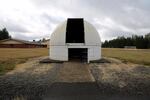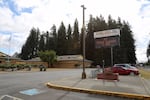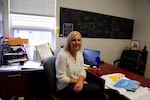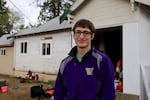On a late summer night in southwest Washington, a small neon "open" sign switched on.
The sign sits above a garage at the end of a road that goes around the back side of Onalaska Middle School. The neon glow is the only light source for several blocks. Beyond that, an open school field is cloaked in darkness.
It’s a little spooky. But Onalaska High School teacher Johnny Garcia said it’s the perfect setting for the night's activity.
“I’m going to take you to Saturn,” Garcia told two of his students who drove down from Centralia College, where he teaches observational astronomy courses.
The students felt their way through the pitch dark and ducked inside a large white dome that houses the 24-inch telescope.

Onalaska's Herold Observatory sits in the middle of a school field. The 24-inch telescope makes it the largest public observatory in Western Washington.
Molly Solomon / OPB
Garcia said on any given night, anywhere from 15 to 100 people show up. On warm nights, sometimes local musicians stop by to play music while people camp out in lawn chairs under the sky and wait to use the telescope.
“One of the promises I made is it’s always open to the public,” Garcia said. “We’re never going to send anybody away.”
Inside the dome, the machinery hummed as Garcia opened the roof to give the telescope a view of the sky.
“Take a peek,” he said as he punched in the coordinates for Saturn and pulled a chair up to the eyepiece.
The detail was startling: Clearly defined rings surrounded the planet and the wide-angle lens picked up all the features.
"You see this little thing right there, this bright smudge?” Garcia asked, gesturing to an area using his pocket laser. “That’s not a cloud. That’s the Milky Way [galaxy].”

Onalaska High School science teacher Johnny Garcia hosts a stargazing event with two of his Centralia College students Shauna Ritter (left) and Hunter Hahn (right).
Molly Solomon / OPB
Johnny Garcia has never met a planetary nebula he hasn’t liked. But some are a cut above the rest.
He perked up when one of his students asked to see NGC 869, an open star cluster located 7,600 light years away.
“Let’s go see Squid Man,” Garcia called out, using a term he and his class adopted after someone made an observation that the streams of stars in the open cluster resemble the legs of a giant squid.
“If you’re in a city, you’ll never see this,” he added.
Garcia has been a science teacher at Onalaska High School since 1995. He also runs an advanced science after-school program — which is where the idea to build this observatory was born.
One of the kids in his class was interested in astronomy and Garcia urged him to pursue a grant for a telescope.
“I was thinking of a 12-inch portable telescope,” Garcia said. “I was not thinking of essentially the second largest public telescope in the state.”
The state’s largest public telescope is in Goldendale, Washington. It beats the Onalaska instrument by about half an inch.
Other telescopes in the state are larger in size, but are private and usually reserved for academic or scientific research.
Building Onalaska’s observatory took close to a decade and included help from several people in the close-knit community.
Garcia described the project as a labor of love and started rattling off names.
There was Mike Turner, the father of one of the students, who donated 300 hours of his time to custom build and assemble every piece. Garcia paid homage by coining the finished product the Turner Telescope.
There’s also the observatory’s namesake Ed Herold, a lifelong amateur astronomer who worked for Weyerhaeuser, a timber company north of town. Herold was able to get his employer to shore up more than $30,000 and became an integral part of fundraising.
“Onalaska is an awesome place to do astronomy,” Herold said. “It’s great to show people things they haven’t seen before. And maybe this will get them on a track to pursue science.”

Onalaska is in rural Lewis County and is a former mill town. The school's motto is on a sign outside: "It’s a great day to be a logger.”
Molly Solomon / OPB
Onalaska sits 8 miles east of Interstate 5, about a 45-minute drive south of Olympia. Less than 1,000 people live in the former mill town and its only major intersection doesn’t even have a stoplight.
“There’s not a lot around here,” said Cheryl Myers, a counselor at Onalaska High School.
“We have a gas station, Brenda’s Market. And that’s kind of the extent of the town,” Myers added.

Onalaska High School counselor Cheryl Myers. For the first time, all 43 seniors last year were accepted into college.
Molly Solomon / OPB
She said the rural campus makes a unique setting for the largest public observatory in western Washington.
“It really opens up the world to these students — the universe actually,” Myers said. “A lot of them haven’t left Onalaska, they haven’t left Lewis County. It’s really special for them to see how much there is.”
Less than 16 percent of residents in Lewis County hold a bachelor’s degree or higher. That’s about half the statewide rate and is one of the lowest of any county in Washington.
Inside Myers’ office, a banner with signatures from this year’s graduating class is taped on the wall behind her, along with the words: “Oh The Places You’ll Go!”
Myers proudly explained that for the first time, all 43 seniors from Onalaska High School were accepted into college.
Noah Halloway, 17, is one of those seniors. He recently spent an evening stargazing with a group of students and school employees at the observatory.
“We looked at star clusters, open clusters, nebulas — it’s lovely,” Halloway said.
Halloway has always been fascinated by space and has been a member of Garcia’s science club for the past three years.
He said being able to see the universe first-hand lifts textbook learning into a new dimension.

Noah Halloway graduated from Onalaska High School this year and spent a lot of time stargazing at the school's observatory. He recently left to pursue a degree in aerospace engineering at the University of Washington.
Molly Solomon / OPB
“Not many people even get to see a telescope or look through it,” Halloway said. “It’s just mind-boggling that I’ve done it multiple times.”
He credits the observatory with inspiring him to start his next journey — one a little closer to home than those planetary nebulas.
Halloway recently made the move to Seattle, where he’s studying aerospace engineering at the University of Washington.
